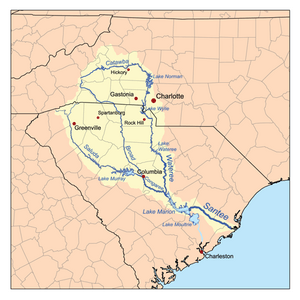Santee River facts for kids
The Santee River is a major river in South Carolina, United States. It stretches about 143 miles (230 km) long. This river and its smaller streams, called tributaries, are very important. They help drain water from a large area of central South Carolina. They also provide a way for boats to travel.
The Santee River flows into the Atlantic Ocean. Its journey starts far away, about 440 miles (710 km) from its most distant source. This source is the Catawba River in North Carolina. A big part of the upper Santee River is now a huge lake. This lake is called Lake Marion.
Contents
About the Santee River
The Santee River is one of the longest rivers in South Carolina. It plays a big role in the state's geography. The river helps shape the land it flows through. It also provides homes for many plants and animals.
Where the River Flows
The Santee River starts from the joining of two other rivers. These are the Congaree River and the Wateree River. It then flows southeast across South Carolina. Finally, it reaches the Atlantic Ocean. The river's path covers a large area. This area is known as its watershed.
Lake Marion and the Santee Dam
A large part of the Santee River is now Lake Marion. This is a huge, horn-shaped lake. It was created by building the Santee Dam. The dam is about 8 miles (13 km) long.
Why the Dam Was Built
The Santee Dam was built in the 1930s. This was during a time when many people needed jobs. The project was part of the WPA. The WPA was a government program. Its main goal was to create jobs during the Great Depression. The dam's main purpose was to produce hydroelectricity. This is electricity made from the power of moving water. It became a big source of power for South Carolina.
Images for kids
-
A grand old bald cypress tree in the Santee River valley, near Andrews, South Carolina
See also
 In Spanish: Río Santee para niños
In Spanish: Río Santee para niños




